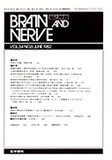Japanese
English
- 有料閲覧
- Abstract 文献概要
- 1ページ目 Look Inside
抄録 CTスキャンで両側側頭葉に障害を有し,当初聴覚失認が疑われたが,4年間の経過観察の結果,心因性であることが判明した40歳女性症例について報告した。患者は生来健康であつたが,前交通動脈瘤の術後,聴覚失認様状態を呈した。①入院中の態度や行動には,全く聴力が失われた患者と類似していたが,末梢性難聴や聴覚失認とは異り,相手によつては突然聞こえが良くなることがあつた。②自覚的聴力検査では,聾を示した。③他覚的聴力検査では,聴性脳幹反応で閾値15dB,緩反応では閾値45dBと正常範囲であり,聴覚伝導路の末梢から脳幹には障害がないと考えられた。④ロールシャッハテストと文章完成法による心理学的検査では,神経症を強く疑わせた。⑤.IQはWAISで全IQ69のボーダーラインを示したが,ただし,患者は非協力的な態度を示しており,実際のIQはもつと良いと患われた。⑥聴覚失認様状態は発症以来持続したが,発症4年目に夫が膵炎のため同室で入院治療するという出来事を契機として突然改善した。以上より,本症例は聴覚失認ではなく,心因性難聴と診断し,本症例の神経心理学的な側面について検討した。
A forty years old woman with hysterical deafness is reported. Chief complaints were bilateral hearing loss. Nothing particular was found in her past and family history. In 1977, on the 11 th day of May, she was admitted to A city hospital because of headache and paresis of right limb. As angiogra-phy revealed an aneurysma of her anterior com-municating artery, she was undertaken the surgery of clipping and coating of the aneurysma. Post-operativery, left hemiparalysis appeared and paresis of right limb developed because of spasm of right middle cerebral artery.
On the 14th day of August, ventricular-peritoneal shunt's operation was performed. As soon as she recovered from postoperative coma, she complained of bilateral hearing loss. Because pure tone audi-ometry demonstrated complete loss of her hearing,she was reffered to ENT department of Teikyo University Hospital.
Findings were as follows:
1) She had a queer way of hearing because she could understand to hear limited persons's peech (her doctor and husband).
2) Pure tone audiometry showed complete loss of her hearing but the thresholds of auditory brain stem responses were 15 dB and those of slow vertex responses were 45 dB. These results sug- gested no lesion in cochlea and brain stem.
3) Rorshach test and sentence complete test were performed. The results of these tests suggested hysterical state or neurotic state.
4) Total inteligent quotinents by WAIS were 69 which indicated bordeline level. However, this value appeared to be incorrect because she was uncooperative.
5) CT scan revealed low density areas at right temporo-parietal lobes and left temporal lobe which were localized and small.
Our findings suggested hysterical deafness but not auditory agnosia.
During three years, she was reffered to several hospitals for rehabilitation but didn't become well at all. On the third year of the onset, her husband became sick and admitted to her room of the same hospital. During that period, suddenly, she talked her hearing to improve and the pure tone audiome-try demonstrated decrease in threshold. In con-clusion, this event could give a final diagnosis of hysterical deafness but not auditory agnosia.

Copyright © 1982, Igaku-Shoin Ltd. All rights reserved.


